AI Art has become a very hot topic within the past few months due to its wild capabilities in “creating artwork.” Is this something that God has put into our lives to give us a new light on what art means? As an upcoming senior Studio Art major at Roberts Wesleyan University and photography intern at Northeastern Seminary this summer, I have seen many different perspectives on what can be considered “art.”
Prior to the introduction of AI, the big debate was if abstract or modern art was justified as a form of art. Most of the population only valued realistic work or pieces with deep contextual meaning. After studying works from as far back as prehistoric times, there is much more to the pieces than just “meaning.” The average person views artists such as Mondrian or Rothko as people who have mocked art and didn’t have any real talent. This has been a debate for hundreds of years as new styles have been introduced to the art world.
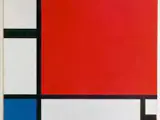
Composition with Large Red Plane, Yellow,
Black, Grey, and Blue (1921)
Piet Mondrian
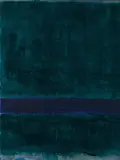
Green, Blue, Green (1969)
Mark Rothko
After actually studying the works and looking closer into why these artists chose to only use two or three colors in their paintings, I realized that deeper meaning could be derived from any part of the process. The intention of brush strokes, the use of certain colors, and the emotion behind every pencil line are what create a piece of art. This is what AI art lacks.
Artificial Intelligence artwork was largely popularized in late 2022 and has since been incorporated by companies such as DALL-E 2 and Adobe. People are discovering its ability to completely alter images and create something new from what seems like nothing. However, you cannot create something from nothing. The program always has to pull its data from somewhere. This is where many artists feel that they are being robbed. Because this advanced technology is so new, there are very few laws that protect outsourced copyrighted imagery, if any at all.
So how does this pertain to me as an upcoming artist?
Within the field of photography, which is my focus, AI has been introduced to platforms like Adobe in order to allow users to alter their images. While it can be helpful for making minor adjustments or fixing borders, it could also be a very dangerous program to introduce to photographers. It is still in its early stages, so it is not as advanced as I’m sure it will become within the next few years. However, from what I’ve seen that has been shared on platforms such as TikTok and Instagram, people are using these features to completely alter their images by adding new objects, removing entire portions of the image, or even creating entirely new scenes. One notable trend allows people to turn regular selfies into photos that appear to be professional headshots with the use of AI. This begs the question, what differentiates photography from a digitally altered image? I do not believe that I am qualified to fully answer this question, but I know that many other emerging photographers are biting their fingernails trying to figure out how they will compete with this upcoming technology.
Here are some side-by-side images of AI-generated photos compared to photos that I have taken:
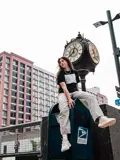
Image taken by myself
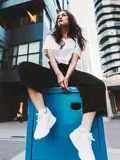
DALL-E image generated from the phrase, “Create an image of a brown-haired girl wearing a black t-shirt, white pants, and white shoes sitting on a blue mailbox in a city.”
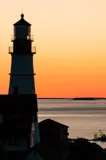
Image taken by myself

DALL-E image generated from the phrase, “Create an up-close image of a silhouetted lighthouse with the sunrise over the ocean and a fishing boat in the lower right-hand corner.”

Image taken by myself
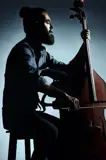
DALL-E image generated from the phrase, “Create an image of a man with dark brown hair and a beard slightly silhouetted in a studio with a blue-gray backdrop sitting on a stool playing the double bass with a bow.”
In Christianity, everyone is given a gift from God. I believe that my gift from God was my inherent creative vision. It is not difficult to see that AI, in general, is fully attacking this idea. People have used it to negate the skill and creativity that every artist works toward. I have spent the majority of the past 10 years of my life making artwork that could inauthentically be “recreated” in seconds by AI. Now, AI is not inherently bad, and it has still done good for our society regardless of everything negative that is going around about it. It has allowed us to get past language barriers, give unbiased opinions, and analyze millions of databases without skipping a beat. But even in a fully controlled environment, it still comes with downsides. It has in turn been used to deep-fake (digitally altering a video/photo of someone to look like a different person), take jobs, and what has been discussed here, AI using artwork from other artists to make “new” pieces without any credit. While it is getting harder and harder to tell the difference between AI and reality, it still lacks the human-like quality of works made by real artists. Is there a benefit to this? Will it eventually allow traditional artists to be valued more? I believe that God will ensure that artists still have a voice and can still use their gifts, even in an artificially controlled world. God has called each of us to be creators in this world, making, believing, building, and imagining everything that exists on our earth. AI is beginning to remove these aspects by taking over that “creating” role. But, in the end, nothing that AI creates can be anywhere near close to as powerful as God’s own creation.
This Blog post was NOT written by Chat GPT. Lol.

About the author
Abby Mertzlufft
My name is Abby Mertzlufft, and I am a senior Studio Art major with a concentration in photography at Roberts Wesleyan University. I have been so grateful to have had the opportunity to be a part of an internship with the marketing team at the Northeastern Seminary, which has allowed me to grow so much in my craft as well as discover new skills in many different programs. I hope to use everything I’ve learned in my future career.